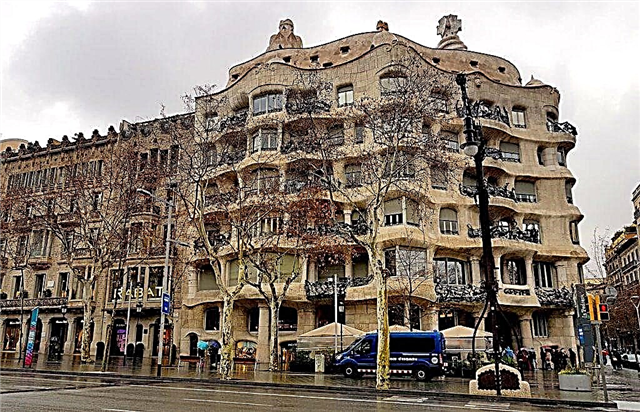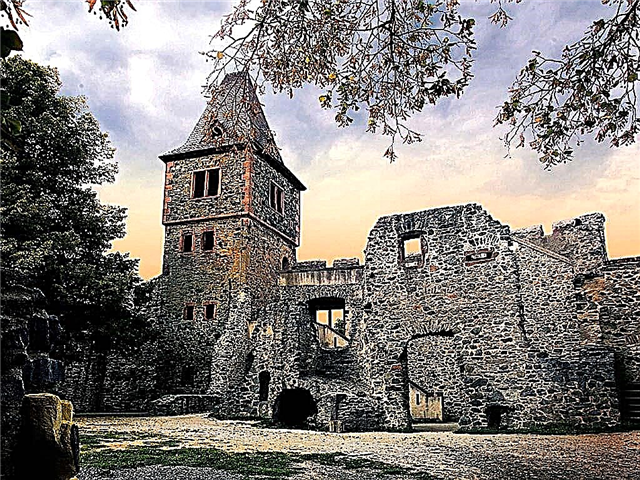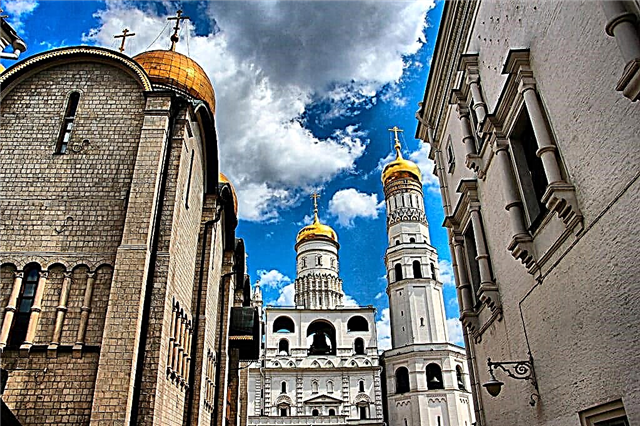The Ivan the Great Bell Tower of the Moscow Kremlin is the center of the architectural ensemble of Cathedral Square. The belfry forms a single composition together with the Filaretov annex and the church. Until the beginning of the 20th century. the tower was the tallest building in the capital. The construction performed a number of important functions. It was used as a watchtower and a fire tower. The bell tower is currently a tourist attraction.
Church of St. John Climacus

The foundation of the belfry was laid on the site of a church that existed in the 14-15th centuries. Church of St. John of the Ladder. The ancient church was built specifically for the bells. In appearance, it resembled ancient Armenian cathedrals. The interior space was divided into parts in a cruciform manner. Outside, the building had the shape of an octagonal.
The altar part was located in a semicircular apse, oriented to the east. A place was set aside for the bells on the 2nd tier of the church. The square adjacent to the cathedral was christened Ivanovskaya. On it, the decrees of the tsar were proclaimed and other important state documents were read. The heralds had to shout loudly, "at all Ivanovo." At the beginning of the 16th century, it was decided to dismantle the Church of St. John of the Ladder and build a bell tower in its place, in memory of the deceased Moscow prince Ivan III "the Great".
History of the construction of the Bell Tower

Foreign architects were invited to manage the construction, unprecedented in Russia in terms of the height of the structure. The project was headed by a native of the Apennine Peninsula, the architect Bon Fryazin. The work lasted 3 years (1505-1508). To ensure reliable fastening of the tower, Fryazin ordered oak piles to be driven into its base. Oak wood under the influence of groundwater acquires colossal strength and reliably holds the entire structure. In this case, the depth of the foundation is no more than 4.3-4.5 meters.
In addition, the architect skillfully used other ways to stabilize the structure:
- metal braces inside brick walls;
- adding eggs to the binder solution;
- thick walls of the lower tier (up to 5 m).
Initially, the plan provided for the creation of a 2-storey building. However, in 1532 it was decided to expand the architectural ensemble, at the expense of the Resurrection Church and the bell tower. The construction work was entrusted to the Italian Peter Francesco Anibala, known in Russia under the nickname Petrok Malaya Fryazin. He added a third tier to the tower, on which a giant bell weighing approx. 1.5 t. The giant had its own name "Evangelist". A ladder was made inside the walls to climb.
The total height of the tower was 81 m. It acquired strategic importance, since the vicinity of the capital could be seen far from the upper platform (at a distance of 30-40 km). To prevent the view from being closed, at the behest of Boris Godunov, it was forbidden to erect buildings in Moscow exceeding the Ivan the Great Bell Tower. The upper decorative superstructure was surrounded by gilded letters. The inscription says that the work on the improvement of the temple was carried out according to the order of Boris Godunov and his son Fyodor.
The first tsar from the Romanov dynasty, Mikhail Fedorovich, ordered to remake the Church of the Resurrection into the Assumption Belfry. An outbuilding was also added to the temple, which began to be called by the name of Patriarch Filaret.
In the completed version, the architectural ensemble combines 3 parts:
- 8-sided tower-shaped bell tower
- church with a belfry in the Pskov-Novgorod style
- wing with hipped roof
Despite its height, the bell tower visually seems light and slender. A similar effect is achieved by gradually narrowing the tiers. The upper part ends with a rounded drum, over which a gilded bulbous dome rises. Stone kokoshniks with pseudo-window openings act as decorative architectural elements.
During the construction of the building, different building materials were used:
- white hewn stone - foundation and plinth
- red brick - the main part of the structure
The fate of the Cathedral of Ivan the Great during the war with Napoleon

After the capture of the Russian capital by Napoleonic troops, the headquarters of General Loriston was located in the bell tower. During the retreat, the French mined and blew up the Kremlin. The Filaretovskaya extension and the Assumption belfry were completely destroyed. The bell tower remained standing, but there was a huge crack along the upper tier.
The gilded cross on top of the dome of Ivan the Great was considered by Muscovites to be a symbol of royal power. Therefore, Bonaparte ordered to remove it. When the French soldiers found out that the product was based on a copper alloy, and not precious metals, they threw the remains at the walls of the Assumption Cathedral. In place of the overthrown cross, a new one was erected, made of iron and covered with gilded copper plates. Its upper crossbar was adorned with the inscription "King of Glory".

The post-war restoration work was headed by the Swiss architect Domenico Gilardi. He was guided by a project drawn up by the architect Luigi Rusca. During the renovation, a white facing stone was used; the decor on the top of the belfries was modified. The main innovation was the relocation of the dome of the Assumption Belfry to the western part of the roof.
Bell tower during the Great Patriotic War
Immediately after the outbreak of hostilities in the summer of 1941, a command post was organized in the building for a military department located on the territory of the Kremlin. It operated from June to September 1941. To establish uninterrupted communication inside the Tsar Bell, at the foot of the belfry, a communications center was equipped.
Restoration of destroyed buildings in the post-war period
At the beginning of the 21st century. for the reconstruction of the architectural ensemble, specialists from the Restorator-M company were involved. In the course of the work, they discovered fragments of an old floor (18th century). A new coating was laid on his model.
The method of fragmentary restoration was also used to preserve the original appearance of the in-wall staircase, doorway, decorative elements (rosettes, cornices, imposts) inside the premises. The work carried out made it possible to leave intact and demonstrate to visitors the original samples of ancient Russian architecture.
About bells

In total, there are 34 bells on the belfry. Among them are foundry items made by craftsmen of the 16-19 centuries. The best alarm bells in Russia were cast in Moscow. The most famous bells had their own names. It was customary to decorate them with bas-reliefs and ornaments. A commemorative inscription was left on each bell with the name of the master, date of manufacture, weight.
A special "bell" alloy was used as a starting material. It consisted of:
- copper
- tin
- silver
- gold
The proportions of metals were set by the master. The sound of the ringing largely depended on the content of the composition. Over time, the bells lost their sonority, cracks formed in the walls and the product was sent for melting. Initially, wooden beams were used to mount the bells on Ivan the Great. In the 19th century, they were gradually replaced by more durable, metal ones.
Assumption bell

The authors of the Festive or Assumption bell are Russian masters Zavyalov and Rusinov. Nabat is characterized by a strong clear sound. This is the most powerful bell on the belfry. Its weight is 65 320 kg.
Bell Howler

The second largest bell on Ivan the Great is the Howler or Reut. It is 2 times smaller than its counterpart in size - 32,760 kg. At the same time, this is the alarm bell - the patriarch. It was made in 1622 by the renowned Russian caster Andrey Chokhov.
Seven hundred bell
The everyday or Seven-hundredth bell was meant for daily use. It is noticeably inferior to loud comrades and weighs 13,071 kg. The creator of the alarm is I. Motorin.
Other bells
Depending on the range of sounds emitted, bells are divided into 3 types:
- zazvonnye - treble
- red
- evangelical - bass
The combination of different sounds creates an overall harmonious chime. Therefore, a whole orchestra of alarm bells was placed on the bell tower. They were distributed over 3 tiers of the tower:
- At the bottom - Swan, Bear, Shirokiy, Novgorodsky, Rostovsky, Slobodskoy.
- On the average - Korsunsky (3 pcs.), Novy, Nemchin, Bezymyanny, Danilovsky, Maryinsky, Glukhoi.
- On the top - Unnamed (3 pcs.).
After the establishment of Soviet power, bell ringing was banned. In 1992, the chime on Ivan the Great sounded again.
Bell tower museums
The room inside the Assumption Belfry was converted into a museum. It contains ancient artifacts, with the help of which the history of the arrangement of the Moscow Kremlin is clearly presented. In the museum collection, visitors can see fragments of existing and already disappeared buildings on the territory of the capital's Detinets.
The exhibition hall serves as a place for the placement of mobile exhibits. Collections on topics were demonstrated here:
- "Royal weddings and coronations in the Moscow Kremlin"
- “The art of preserving art. Restoration in the Moscow Kremlin Museums "
- "The Golden Age of the English Court: From Henry VIII to Charles I"
- "India. Jewels that conquered the world "
Ivan the Great Bell Tower today

In addition to being a tourist attraction, the belfry fulfills its main purpose. Its bells sounded again after an almost 75-year hiatus, in honor of the Easter holidays in 1992. It is on the Ivan the Great Tower that the first bells begin to ring on the days of the main church holidays.
Before the bells started working again, they passed the examination. Less often than others, the huge Festive Bell is struck. Since it requires several bell ringers to work with it. The bell tongue weighs 2 thousand kg. On the upper tier, located at an altitude of 80 m, there is an observation deck. Visitors can climb it during the warmer months. However, the path of 329 steps must be covered on foot.
Opening hours and ticket prices

The museum and the observation deck on the upper tier of the tower are available for visiting only during the warm season (May-September). The composition of the group should not exceed 10 people. Children under 14 years old are not admitted. Sessions are held daily, strictly in time. Day off - Thursday. Tickets are sold at the box office near the Kutafya Tower 45 minutes before the start of the tour. Ticket price 250 rubles.
Where is the Bell Tower and how to get there
The object is located at the address: Cathedral Square, Kremlin, Moscow. Tourists are advised to choose the metro in order to arrive at the stations closest to the Kremlin:
- Sokolnicheskaya line - "Library named after Lenin "," Okhotny Ryad "
- Serpukhovsko-Timiryazevskaya line - "Borovitskaya"
- Arbatsko-Pokrovskaya line - "Revolution Square"
- Filyovskaya line - "Aleksandrovsky Sad"











